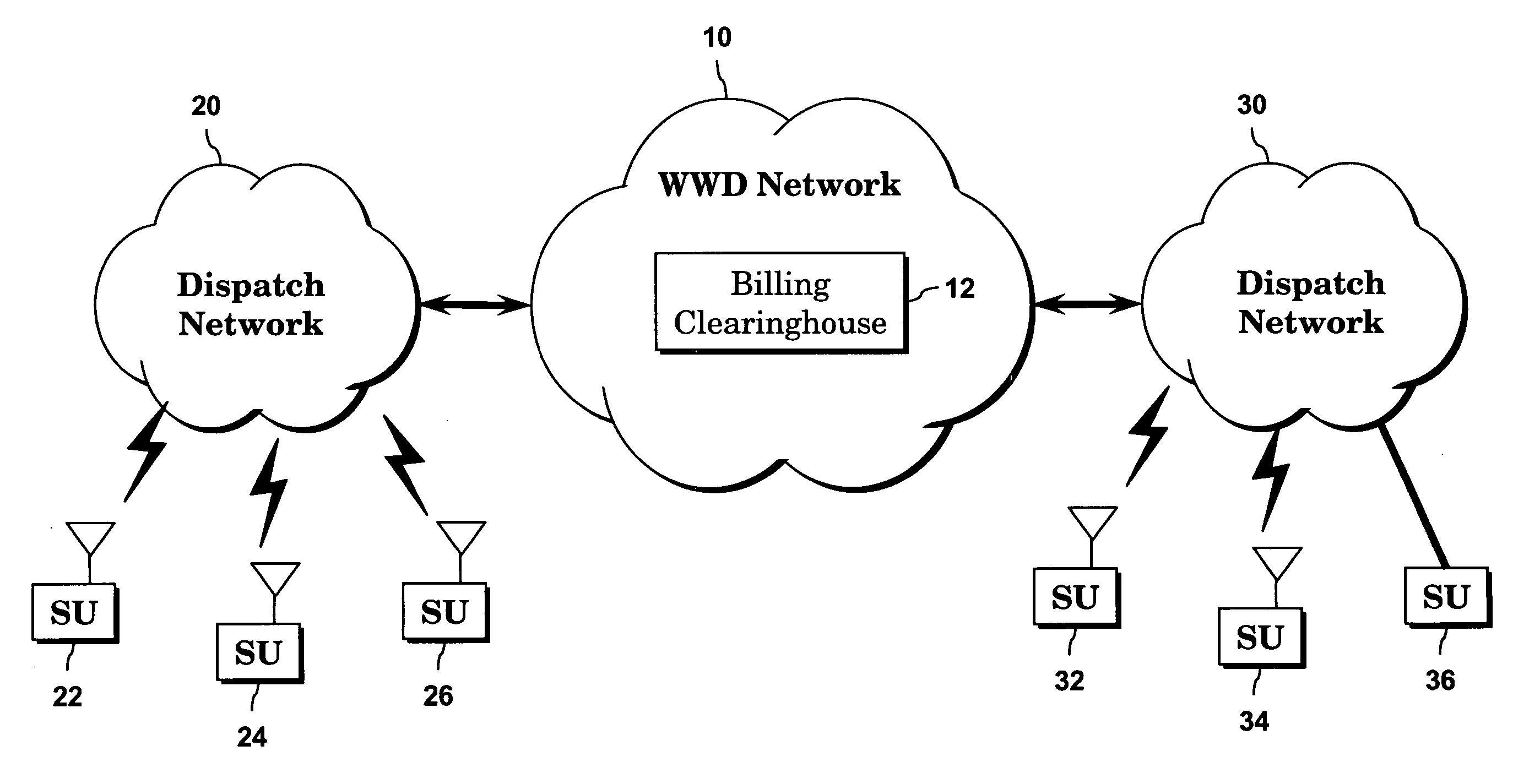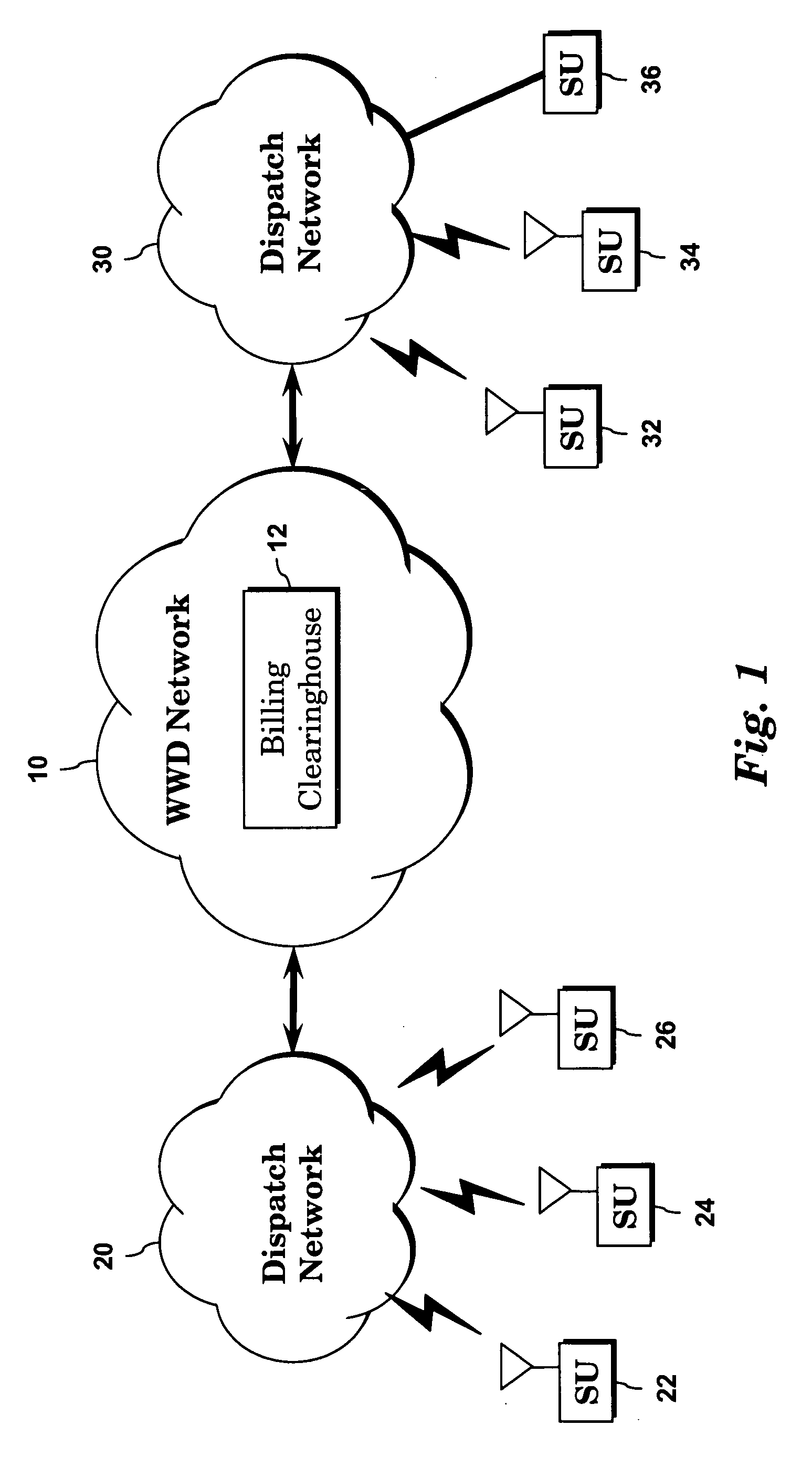System and method for facilitating roaming of push to talk subscribers across disparate dispatch networks
a technology of push to talk and dispatch network, applied in the field of system and method for facilitating the roaming of push to talk subscribers, can solve the problems of limited ptt calls, inability to connect a large number of wireless carriers and technologies on a worldwide basis, and extensive modification, so as to facilitate the roaming of ptt subscribers and facilitate the operation of dispatch communications. , the effect of facilitating the roaming of p
- Summary
- Abstract
- Description
- Claims
- Application Information
AI Technical Summary
Benefits of technology
Problems solved by technology
Method used
Image
Examples
first embodiment
[0056] Referring to FIG. 4, a physical architecture to facilitate PTT interoperability across wireless carriers with disparate PTT technologies is illustrated. The architecture includes core network components 180 and regional network components 190. The core network components 180 include core inter-working components 200, a billing clearinghouse system 220 and a service delivery architecture 222. The core inter-working components 200 include network management systems 202, a location server 204, a group server 206, a policy server 208, an address translation server 210 and a centralized database 212.
[0057] The regional network 190 includes at least one point-of-presence (POP), such as POPs 240, 242 and 244. Each POP 240, 242 and 244 includes at least one custom PTT gateway (GW), an Authentication, Authorization and Accounting function (AAA) and a regional database (DB). The data in each regional database DB is replicated and synchronized with the central database 212. In one embod...
second embodiment
[0063] an architecture to facilitate PTT interoperability across wireless carriers with disparate PTT technologies is illustrated in FIG. 6. In this embodiment, the originating call is translated into a common signaling format within the WWD network before session processing, regardless of the originating and terminating technologies. After processing, the session is translated into the format of the terminating technology before being forwarded to the called party.
[0064] The second embodiment may include the same core network components 180, border gateways 250 and carrier networks 252 of the first embodiment illustrated in FIG. 4. The regional network components 290 include a plurality of POPs, such as POPs 300, 310 and 320. Each POP includes a signaling controller (302, 312, and 322, respectively), a signaling bridge (304, 314 and 324, respectively), and a media gateway (306, 316 and 326, respectively). Since every session is translated into a common format, custom gateways as us...
fourth embodiment
[0087] Referring to FIG. 11, in a fourth embodiment at least one carrier network 650 includes a proxy server 652 and a signaling bridge 654. The carrier network 650 is connected to the WWD network through a border gateway 656 and a POP 658. The proxy and signaling bridge functions are included in the POP 658 (or other POPs) to serve carriers who have not deployed the signaling bridge functionality as part of their PTT infrastructure deployment. In this embodiment, the signaling traffic received from the carrier 650 by the WWD network is already in the common WWD format, as the translation is done by the carrier premises before its gets forwarded to the WWD network for further processing. The POP 658 may still determine whether conversion is required, as the session may have originated from a carrier that does not perform its own conversion. The core WWD infrastructure includes the components previously described in other embodiments.
[0088] An embodiment of the operation of the archi...
PUM
 Login to View More
Login to View More Abstract
Description
Claims
Application Information
 Login to View More
Login to View More - R&D
- Intellectual Property
- Life Sciences
- Materials
- Tech Scout
- Unparalleled Data Quality
- Higher Quality Content
- 60% Fewer Hallucinations
Browse by: Latest US Patents, China's latest patents, Technical Efficacy Thesaurus, Application Domain, Technology Topic, Popular Technical Reports.
© 2025 PatSnap. All rights reserved.Legal|Privacy policy|Modern Slavery Act Transparency Statement|Sitemap|About US| Contact US: help@patsnap.com



